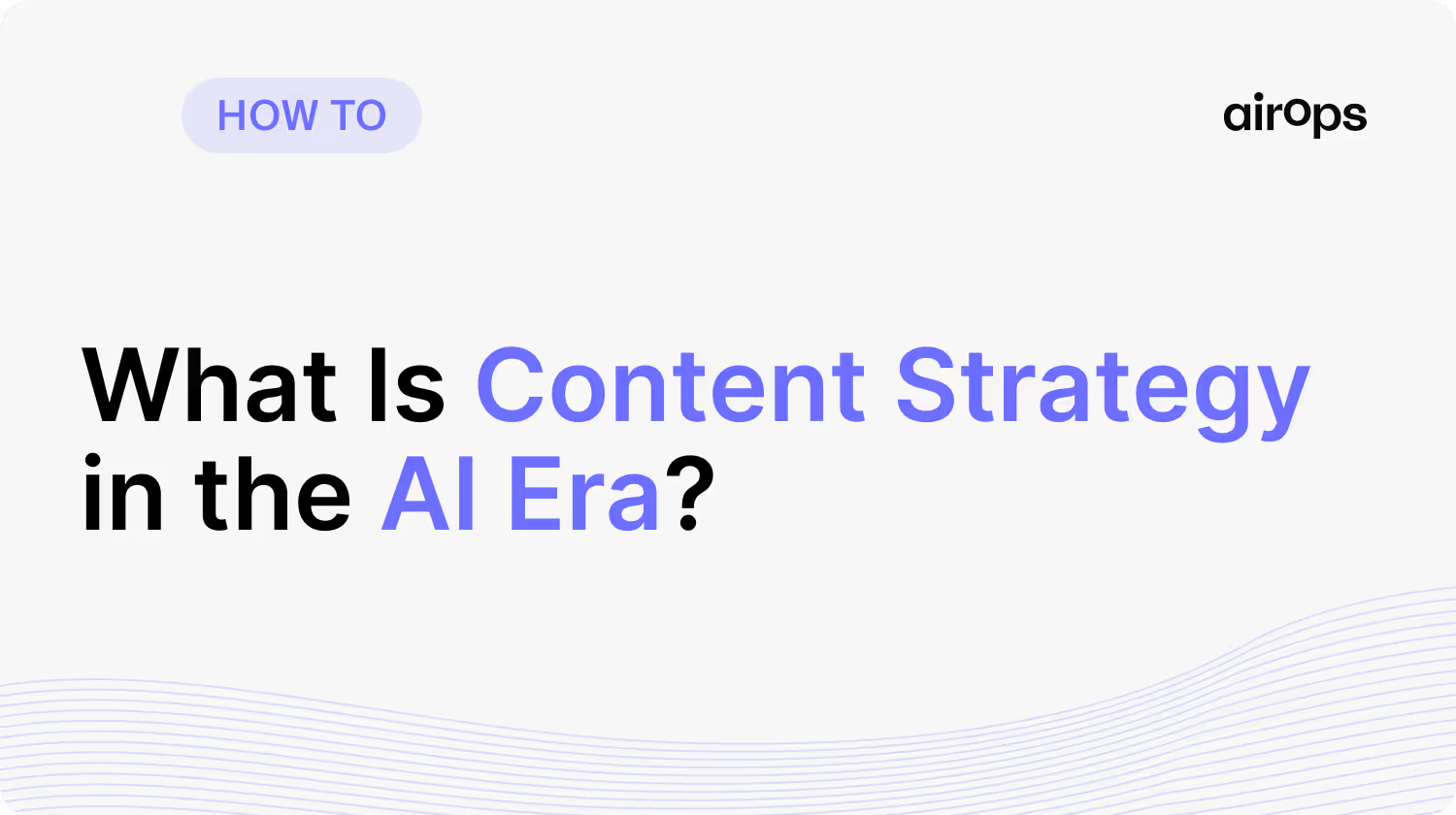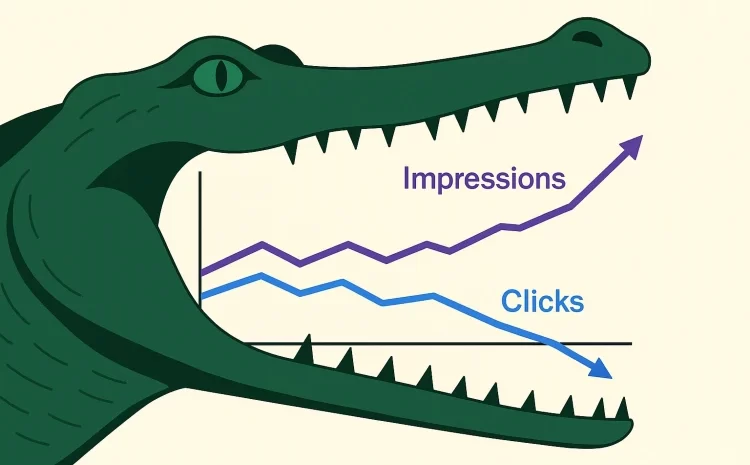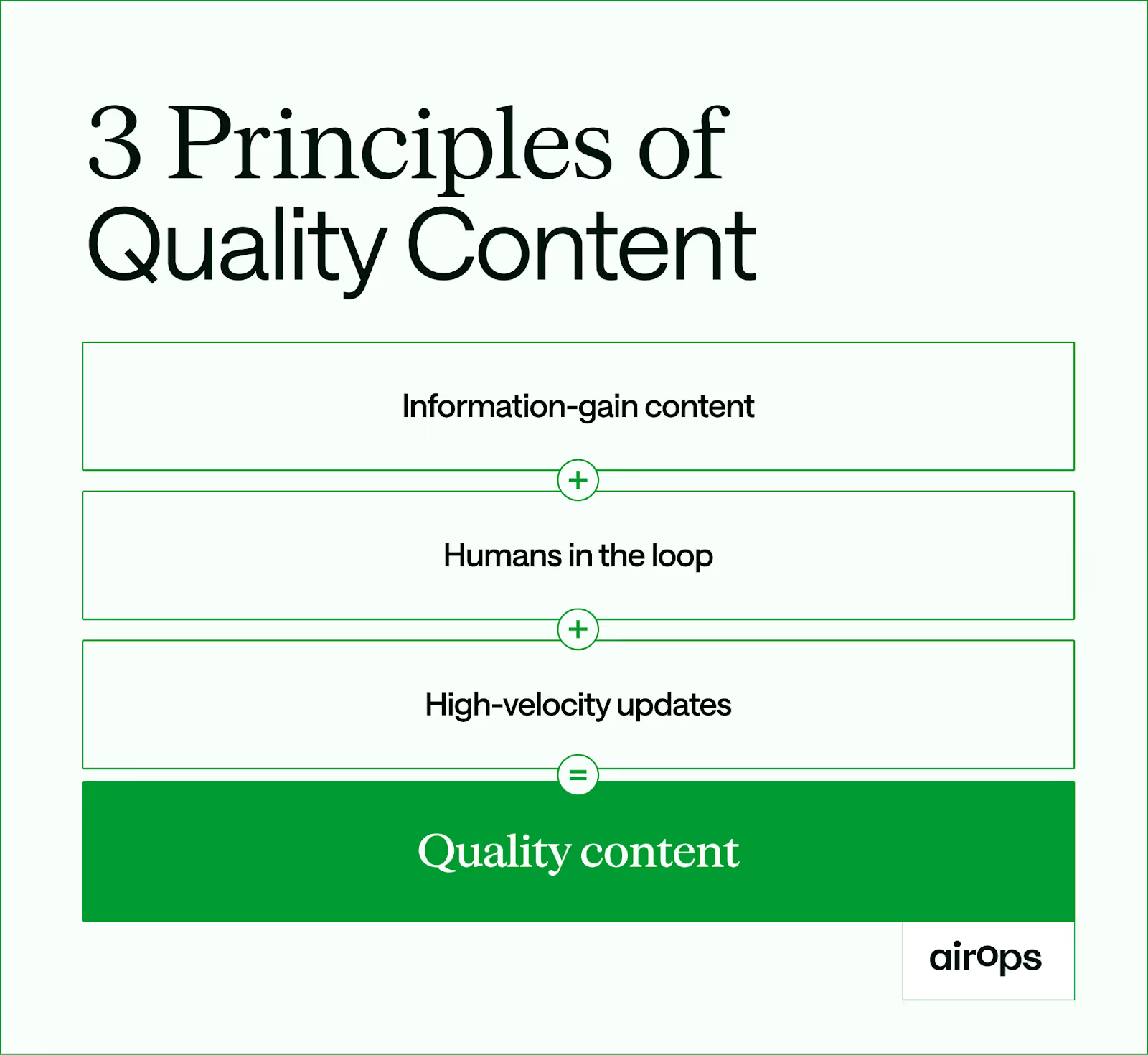Should Your Content Strategy Be Different for AI Search?

- Content now needs to win on two fronts: traditional search and AI answer engines, so you keep visibility and authority.
- Signals of authority and original research beat generic posts, since AI tools favor unique, verifiable info they cannot copy.
- Structured data, clear formatting, and question-and-answer patterns are now essential so AI systems can parse and cite your content.
- New metrics like AI visibility and citation frequency are starting to replace traffic alone as the main signs of content success.
Content strategy has changed as AI answer boxes reshape how people find information. There's a crocodile effect happening, where clicks are often separating from impressions.
Your content now has to win in two places at once: classic search results and AI answers. If you miss this shift, you hand pipeline to competitors who get the new rules.

How Do I Build a Content Strategy That Helps SEO and AI Visibility?
To serve both SEO and AI, create credible content that people value and systems can pull into answers. Start by auditing your library for how easy it is to extract key facts and where you show proof of authority. Focus on structured data, clean formatting, and complete topic coverage across formats.

Winning on both fronts comes down to three core elements:
- Authority-first content creation: Publish original research, expert insights, and proprietary data that AI systems cannot copy or skip when forming answers.
- Technical setup for extraction: Use schema markup, clear headings, and question-and-answer formats that help AI systems parse and cite your information.
- Comprehensive topic clusters: Build connected content hubs that cover every angle of your core topics to earn clear topical authority.
Together, these elements help you rank in search and earn citations in AI answers.
How Should I Plan Content for Both Humans and AI Search Engines?
Plan dual-purpose content that works for both people and AI. People want engaging stories. AI needs clear, structured facts. Do both by weaving crisp data points into simple, compelling narratives.
Effective dual-purpose planning includes:
- Hybrid content formats: Create deep guides with quick summaries, FAQs, and data tables inside long-form pieces that are enjoyable to read.
- Smart keyword and entity mapping: Cover conversational queries for AI and classic keywords for SEO using natural language variations.
- Multi-format production: Share the same core ideas across articles, videos, infographics, and structured data to increase your chances to be seen.
This approach helps your content perform across all discovery channels without losing clarity or quality.
How Do I Plan Content Around AI Search Behaviors?
Plan with an understanding of how AI finds and ranks information. These systems favor fresh, credible content with clear answers to specific questions. Your plan should reflect how AI pulls, blends, and presents information.
Key AI behavior patterns to address:
- Zero-click answers: Place concise, complete answers in your content so AI can surface them directly without a click.
- Freshness signals: Keep content current with recent data, since AI systems favor newly verified information over older pages. According to AirOps research, pages updated within the last 12 months made up more than 95% of citations across leading brands, with companies like NinjaOne and ActiveCampaign refreshing high-value pages quarterly.
- Citation worthiness: Boost your chance of being cited with clear statements, trustworthy sources, and definitive answers.
According to Pew Research Center, Google users clicked links inside AI summaries in only 1% of visits where a summary appeared, and they were more likely to end their session on those pages (26% vs. 16% without summaries).
Use this behavior to present succinct, self-contained answers with clear next steps such as CTAs, internal links, and downloadable assets. That way you still capture value when clicks are scarce. Knowing these patterns helps you craft content that AI systems are more likely to select and reference.
How Do I Use Search Intent to Plan Top, Middle, and Bottom Funnel Content?
Match content depth and format to the stage of the journey. Top-of-funnel content answers broad questions. Bottom-of-funnel content tackles product specifics, comparisons, and features. Map each piece to clear intent signals and a defined stage in the buyer journey.
Intent-based planning follows this framework:
- Top-funnel awareness content: Publish educational guides that answer "what is" and "how to" queries with broad appeal and high share value.
- Middle-funnel consideration content: Create comparisons, case studies, and solution overviews that weigh options and build trust.
- Bottom-funnel decision content: Deliver detailed product pages, ROI calculators, and implementation guides that drive conversions.
This structure ensures every piece moves prospects forward with a clear purpose.
What Content Strategy Frameworks Do Growth Marketers Use?
Growth teams rely on repeatable systems that balance quality, speed, and outcomes. The best approaches blend programmatic production with human expertise and data-led improvements. This mix allows fast testing and iteration while keeping your brand consistent.
Leading frameworks include:
- GACCS framework: Goals, Audience, Creative, Channels, and Stakeholders alignment so every piece has a clear plan for distribution and measurement.
- Topic cluster methodology: Build content hubs around core topics with pillar pages and supporting articles that prove topical authority. Modern entity-based topic clusters go beyond keywords to form semantic relationships that AI systems recognize and reward.
- Programmatic SEO scaling: Use templates and automation to ship many targeted pages while keeping quality with human review.
These frameworks help teams scale content fast without losing strategy or standards.
What Are Content Strategy Best Practices for B2B Brands?
B2B content should prove expertise, build trust, and support long, complex buying cycles. Buyers want deeper technical detail, clear ROI, and multiple touchpoints before they convert. Your plan must serve different stakeholders with different needs and levels of authority.
Essential B2B practices include:
- Account-based content mapping: Create content for specific roles in target accounts, with each piece speaking to their unique pains and priorities.
- Original research and data: Publish proprietary studies, benchmarks, and expert analysis that make your brand the authority.
- Long-form technical content: Produce comprehensive guides, whitepapers, and documentation that show real depth and implementation know-how.
According to Gartner, 61% of B2B buyers now prefer a rep-free buying experience, reinforcing the need for authoritative digital content that enables self-serve evaluation.
Act on this by building buyer enablement assets such as comparison matrices, ROI models, and implementation playbooks that help stakeholders self-validate before they talk to sales. This approach positions your brand as the trusted resource through a long B2B cycle.
What Role Does SERP Analysis Play in Content Planning?
SERP analysis shows which formats and topics are winning now. Studying the results reveals the content types Google and AI systems favor for each query. Use these insights to pick the right format, depth, and on-page improvements for the biggest impact.
SERP analysis reveals key planning insights:
- Content format preferences: See whether a query calls for videos, lists, guides, or tools, then match the leading format.
- Featured snippet opportunities: Find queries where structured answers can earn position zero through focused improvements. Adding structured data for AI visibility raises your odds of winning those spots.
- Competitive content gaps: Spot topics where others rank but lack complete coverage that you can provide.
Regular SERP reviews keep your plan aligned with what actually ranks, not assumptions.
What's the Best Way to Align Blog Content with AI Search Trends?
Watch how AI platforms surface and cite information. Track which formats and topics show up again and again in AI responses. Use those findings to structure blog content for strong AI visibility and a higher chance of citation.
Helpful tactics include:
- Conversational content: Write in natural question-and-answer formats that reflect how people talk to assistants.
- Entity-based structuring: Build around entities and relationships that AI systems can easily spot and connect.
- Multi-source validation: Cite diverse, trustworthy sources that AI systems recognize for fact checks and verification.
This positions your blog as a go-to source for AI answers in your space. Winning now means getting good at both classic SEO and the new ways AI search works at the same time. Focus on authoritative, well-structured content that serves readers and is easy for AI to pull.
- Build dual-purpose content: Create assets that engage people and offer clear, extractable facts for AI. Companies using AI content strategy frameworks report strong gains in both rankings and AI citations.
- Put authority and originality first: Share unique insights, proprietary data, and expert opinions that AI cannot produce on its own.
- Structure for extraction: Use clean formatting, schema, and question-and-answer patterns that make parsing and citation easier.
- Monitor new metrics: Track AI visibility, citation frequency, and brand mentions along with classic SEO metrics.
- Update often: Refresh content so you keep the freshness signals that both search engines and AI platforms favor.
Win AI Search with Great Content Execution
Most brands are losing ground as AI changes search because they cannot track or improve for both classic and AI discovery. AirOps helps teams build content plans that win across every surface.
- Track your presence across AI answer engines and find content opportunities competitors miss.
- Create authoritative content at scale using AI workflows that keep your brand voice and quality intact.
- Refresh existing content to meet AI citation needs while protecting SEO rankings.
- Measure AI visibility to see your true impact, not just traffic.
Ready to level up your content for the AI era? Book a call to see how AirOps helps brands build winning content at scale.
Win AI Search.
Increase brand visibility across AI search and Google with the only platform taking you from insights to action.
Get the latest on AI content & marketing
Get the latest in growth and AI workflows delivered to your inbox each week



.avif)

